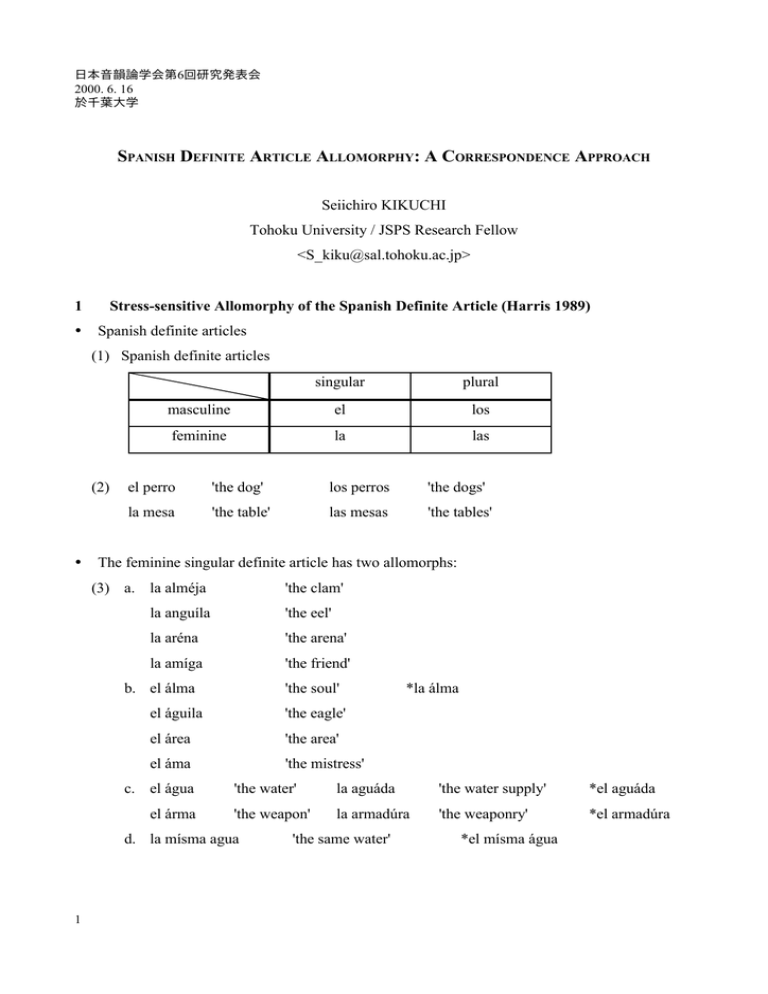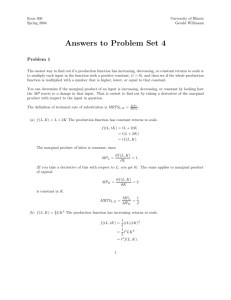Spanish definite article allomorphy: A correspondence approach
advertisement

日本音韻論学会第6回研究発表会
2000. 6. 16
於千葉大学
SPANISH DEFINITE ARTICLE ALLOMORPHY: A CORRESPONDENCE APPROACH
Seiichiro KIKUCHI
Tohoku University / JSPS Research Fellow
<S_kiku@sal.tohoku.ac.jp>
1
y
Stress-sensitive Allomorphy of the Spanish Definite Article (Harris 1989)
Spanish definite articles
(1) Spanish definite articles
(2)
y
singular
plural
masculine
el
los
feminine
la
las
el perro
'the dog'
los perros
'the dogs'
la mesa
'the table'
las mesas
'the tables'
The feminine singular definite article has two allomorphs:
(3) a. la alméja
'the clam'
la anguíla
'the eel'
la aréna
'the arena'
la amíga
'the friend'
b. el álma
'the soul'
el águila
'the eagle'
el área
'the area'
el áma
'the mistress'
c. el água
el árma
'the water'
la aguáda
'the water supply'
*el aguáda
'the weapon'
la armadúra
'the weaponry'
*el armadúra
d. la mísma agua
1
*la álma
'the same water'
*el mísma água
(4) a. el amígo
el ánimo
b. los amígos
los ánimos
c. las amígas
las ámas
'the friend'
'the spirit'
'the friends'
'the spirits'
'the friends'
'the mistress'
[Observations]
¾ The fem. sg. definite article is la (3a). However, when it precedes a noun beginning with a
stressed á, el occurs instead (3b).
¾ The occurrence of el is not morpheme-specific: if the stress is shifted from the initial
syllable, la occurs (3c). If the definite article is not adjacent to the noun, la occurs (3d).
¾ The definite articles other than the fem. sg. do not show allomorphy (4).
y
El opaquely occurs in diminutives and compounds.
(5) a.
b.
Diminutives
el amíta
'the mistress (dim.)'
el áma
cf. la amíga
el almíta
'the soul (dim.)'
el álma
cf. la alméja
Compounds
el aguafuérte
'etching'
el água
el aguamála
'jellyfish'
el água
[Observations]
¾ In diminutives and compounds which are derived from the noun with an initial stressed á, el
occurs even though the following noun-initial vowel is not stressed.
The aim of this paper is to provide the answers to the following questions:
(6)
a.
Why does la change to el before the noun beginning with a stressed á?
b.
Why does only the fem. sg. article show allomorphy?
c.
Why does el opaquely occur in diminutives and compounds?
2
2
Allomorphy and Resyllabification in Spanish
2.1 Spanish resyllabification (Hutchinson 1974, Harris 1983, Roca 1991)
(7)
a.
b.
color azul
co.lo.ra.zul
'blue color'
tan alto
ta.nal.to
'so tall'
mi (h)ijo
mi.jo
'my son'
lo odio
lo.dio
'I hate it'
[Observations]
¾ The word-final consonant is resyllabified as the onset of the following word-initial onsetless
syllable (7a).
¾ Across the word boundary, a sequence of two identical vowels is merged into a single vowel
(7b).
2.2 Allomorphy as the coalescence avoidance in stressed syllable
(8)
Definite article allomorphy and resyllabification
a.
la1 a2míga
la12.mí.ga
b.
el áma
e.lá.ma
*la1 á2ma
*lá12.ma
el ánimo
e.lá.ni.mo
los ánimos
lo.sá.ni.mos
las ámas
la.sá.mas
c.
[Descriptions]
(8a): Across the word boundary, a sequence of two identical vowels is coalesced to avoid an
onsetless syllable.
(8b): Vowel coalescence is not allowed in the stressed syllable. In the case where one of the
two adjacent vowels is stressed, the allomorph el occurs. This is an instance of the
Positional Faithfulness effect (Beckman 1998).
(8c): Since the articles other than the fem. sg. are consonant-final, they do not show
allomorphy.
3
3
A Correspondence Analysis of Spanish Definite Article Allomorphy
3.1
y
Allomorphy
Positional faithfulness constraint against coalescence in stressed syllable
(9) UNIFORMITYIO-σ@
No segment in a stressed syllable in the output has multiple correspondents in the input.
cf.
UNIFORMITYIO
No segment in the output has multiple correspondents in the input.
y
Other relevant constraints
(10) a.
*ViVi: Avoid sequence of two identical vowels.
b.
ONSET: Avoid onsetless syllable.
c.
DEPIO-C: Output consonants must have input correspondents.
d.
*Resyllabification (= ANCHORIO(stem, σ, initial)):
The initial segment of the stem in the input must be in correspondence with a
syllable-initial segment in the output.
y
Tentative assumptions
(11) Lexical items that show allomorphic alternations contain more than one underlying
representations. The allomorphic choice is determined by constraint evaluation (Kager
1996, Mascaró 1996).
(12) Underlying representation of the fem. sg. definite article
DEF
y
= /la, el/
The constraint ranking for Spanish definite article allomorphy (first approximation)
(13)
UNIFORMITYIO-σ@, DEPIO-C, *ViVi » ONSET » UNIFORMITYIO, *Resyllabification
4
y
Evaluations1
Ö
(14) la occurs before an unstressed a: [DEF [amiga]]
la.mí.ga
Candidates: a. /la1 [a2miga/
Ö
la1.[a2.mí.ga
Faithful (no resyllabification)
b. /la1 [a2miga/
Ö
l[a12.mí.ga
Coalescence
c. /la1 [a2miga/
Ö
la1.t[a2.mí.ga
Epenthesis
d. /el [a.mi.ga/
Ö
e.l[a.mí.ga
el occurs.
UNIFORM-σ@
DEP-C
a. la1.[a2.mí.ga
*ViVi
ONSET
*!
*
☞ b. l[a12.mí.ga
c. la1.t[a2.mí.ga
UNIFORM
*Resyl
*
*
*!
*
d. e.l[a.mí.ga
*!
*
[Crucial rankings]
ONSET » *Resyl:
Resyllabification
*ViVi, DEP-C » ONSET » UNIFORM: A sequence of the identical vowels across the word
boundary is coalesced into a single vowel.
(15) el occurs before a stressed á:
[DEF [agua]] Ö
e.lá.gua
Candidates: a. /la1 [a2gua/
Ö
la1.[á2.gua
Faithful (no resyllabification)
b. /la1 [a2gua/
Ö
l[á12.gua
Coalescence
c. /la1 [a2gua/
Ö
la1.t[á2.gua
Epenthesis
d. /el [agua/
Ö
e.l[á.gua
el occurs.
UNIFORM-σ@
DEP-C
a. la1.[á2.gua
b. l[á12.gua
*ViVi
ONSET
*!
*
*!
c. la1.t[á2.gua
UNIFORM
*Resyl
*
*
*!
☞ d. e.l[á.gua
*
*
[Crucial ranking]
UNIFORM-σ@ » ONSET:
1
5
Vowel coalescence is not allowed in the stressed syllable.
"[ ]" indicates morpheme boundaries.
*
(16) la occurs when the suffixation removes the stress from the noun-initial vowel:
[DEF [[agua] da]
Ö la.guá.da
Candidates: a. /la1 [a2guada/
Ö
la1.[a2.guá.da
Faithful (No resyllabification)
b.
/la1 [a2guada/
Ö
l[a12.guá.da
Coalescence
c.
/la1 [a2guada/
Ö
la1.t[a2.guá.da
Epenthesis
d.
/el [aguada/
Ö
e.l[a.guá.da
el occurs
UNIFORM-σ@
DEP-C
*ViVi
ONSET
*!
*
a. la1.[a2.guá.da
UNIFORM
*Resyl
*
*
☞ b. l[a12.guá.da
c. la1.t[a2.guá.da
*!
d. e.l[a.guá.da
3.2
y
*
*!
*
On the phonological shape of el
Why does la alternate with el but not with other forms ?
¾ The multiple UR assumption (12-13) gives no explanation for this question, because el is
merely stipulated as an alternate form of la.
Proposal
(17) In order to account for the phonological shape of the allomorph el, I assume a single
underlying representation /la/ for the Spanish feminine singular definite article, and
propose a constraint on the minimum size of functional words in (18).
(18) Minimum Size Requirement on functional words (MSR)
An input functional word must have an output exponent that can form a syllable by
itself. That is, the output exponents of the articles must be V, CV, VC, or CVC.
(19) Other relevant constraints
a. MAXIO:
Input segments must have output correspondents.
b. DEPIO-V:
Output vowels must have input correspondents.
(20) The constraint ranking for Spanish definite article allomorphy (revised)2
MSR, UNIFORMIO-σ@, DEPIO-C, *ViVi » MAXIO, DEPIO-V » ONSET » UNIFORMIO, *Resyl
2
The ranking MAXIO » ONSET is supported by the fact that the vowel deletion is never attested in Spanish. The ranking
between DEPIO-V and ONSET cannot be decided because hiatus never be resolved by vowel epenthesis.
6
y
Evaluations
Ö
(21) el occurs before a stressed á: [la [ama]]
e.lá.ma
Candidates3: a. /la1 [a2ma/
Ö
la1.[á2.ma
Faithful (no resyllabification)
b. /la1 [a2ma/
Ö
l[á12.ma
Coalescence
c. /la1 [a2ma/
Ö
l[á2.ma
Deletion
d. /la1 [a2ma/
Ö
e.l[á2.ma
Deletion and epenthesis (result in the
occurrence of el)
MSR
UNIFORM-σ@
*ViVi
a. la1.[á2.ma
MAX
DEP-V
*!
b. l[á12.ma
ONSET
UNIFORM
*
*!
c. l[á2.ma
*
*!
*
☞ d. e.l[á2.ma
*
*
*
[Crucial rankings]
UNIFORM-σ@, *ViVi » MAXIO: The article-final vowel is deleted to resolve the sequence of
identical vowels, when the following noun-initial vowel is
stressed.
MSR » DEPIO-V: e is epenthesised before l.
(22) la occurs before an unstressed a: [la [amiga]] Ö
la.mí.ga
Ö la1.[a2.mí.ga
Faithful (no resyllabification)
b. /la1 [a2miga/
Ö l[a12.mí.ga
Coalescence
c. /la1 [a2miga/
Ö l[a2.mí.ga
Deletion
d. /la1 [a2.mi.ga/
Ö e.l[a2.mí.ga
Deletion and Epenthesis (result in el)
Candidates: a. /la1 [a2miga/
MSR
UNIFORM-σ@
a. la1.[a2.mí.ga
*ViVi
MAX
DEP-V
*!
ONSET
*
☞ b. l[a12.mí.ga
c. l[a2.mí.ga
*
*!
d. e.l[a2.mí.ga
3
7
UNIFORM
The exponent of the article is underscored.
*
*!
*!
*
[Crucial ranking]
MAXIO, DEPIO-V » UNIFORMIO: Vowel coalescence is preferred to both deletion and epenthesis
in the case where neither of the two adjacent vowels is
stressed (that is, UNIFORMIO-σ@ is not relevant).
3.3
Opacity in diminutives and compounds
(23) a. Diminutives
el amíta
'the mistress (diminutive)'
cf. el água
el áma
la aguáda
b. Compounds
el aguamála
'the jellyfish'
[Observations]
¾ In diminutives and compounds which are derived from the noun with an initial stressed á, el
opaquely occurs even though the following noun-initial vowel is not stressed.
y
The ranking in (20) fails to account for the opacity in (23).
(24) la wrongly occurs in diminutives:
Ö
[la [[am] ita]]
*la.mí.ta
Candidates: a.
/la1 [a2mita/
Ö
la1.[a2.mí.ta
Faithful (No resyllabification)
b.
/la1 [a2mita/
Ö
l[a12.mí.ta
Coalescence
c.
/la1 [a2mita/
Ö
e.l[a2.mí.ta
el occurs (deletion and epenthesis)
UNIFORM-σ@
a. la1.[a2.mí.ta
/
*ViVi
MAX
DEP-V
*!
ONSET
*
wrong winner
*
b. l[a12.mí.ta
desired winner
c. e.l[a2.mí.ta
UNIFORM
*!
*
*
Solution
(25) The diminutive suffix and the compound-trigger morpheme are sympathetic morphemes:
they have a lexical specification k-selector = ANCHORIO(stem, prosodic word, final). That
is, the word headed by these affixes must be faithful to the k-ed candidate selected by
ANCHORIO(stem, prosodic word, final).
8
(26) The k-selector for the Spanish diminutives and compounds
k-ANCHORIO(stem, prosodic word, final):
The final segment of the stem in the input must be in correspondence
with a final segment of the prosodic word in the output.
(27) Sympathetic faithfulness constraint
MAXkO: Every segment in the k-ed candidate has a correspondent in the output.
(28) The constraint ranking for Spanish definite article allomorphy4
MAXkO, MSR » UNIFORMITYIO-σ@, *ViVi, DEPIO-C » MAXIO, DEPIO-V » ONSET »
UNIFORMITYIO, *Resyl
y
Evaluations
(29) el opaquely occurs before an unstressed a in diminutives: [la [[am] it a]] Ö
e.la.mí.ta
Candidates5:
The stem-final boundary does not correspond to a prosodic word boundary
a.
/la1 [a2m] ita/
Ö
{la1.[a2.m]í.ta}
No resyllabification
b.
/la1 [a2m] ita/
Ö
{l[a12.m]í.ta}
Coalescence
c.
/la1 [a2m] ita/
Ö
{e.l[a2.m]í.ta}
el occurs (deletion and epenthesis)
The stem-final boundary corresponds to a prosodic word boundary
4
5
9
d.
/la1 [a2m] ita/
Ö
{{la1.[á2m.]} í.ta}
Faithful (No resyllabification)
e.
/la1 [a2m] ita/
Ö
{{l[á12m.]} í.ta}}
Coalescence
f.
/la1 [a2m] ita/
Ö
{{e.l[á2m]} í.ta}}
el occurs (deletion and epenthesis)
The relative ranking of the k-selector k-ANCHORIO(stem, prosodic word, final) cannot be determined by the data.
However, in order to avoid prosodic word recursion on the surface, it must be outranked by GRWD=PRWD, which
requires a grammatical word to correspond to a prosodic word.
"[ ]" = morpheme boundary, "{ }" = prosodic word boundary
MAXkO UNIFORM-σ@
a. la1.[a2.m]í.ta}
*!
b. l[a12.m]í.ta}
*!
*ViVi
MAXIO
*
e. l[á12m.]} í.ta
*!
k
ANCHORIO
*
*
*
*!
ONS UNIFORM
*
☞ c. e.l[a2.m]í.ta}
d. la1.[á2m.]} í.ta
DEPIO
*
*
*
*
*
**
9
*
k f. e.l[á2m]} í.ta
*
*
*
*
**!
9
9
[Crucial constraint and ranking]
MAXkO » DEPIO-V: The optimal candidate has an epenthetic e because the k-ed candidate,
in which the article immediately precedes the noun-initial stressed á, has
e in the phrase-initial position.
ONSET:
The k-ed candidate itself is ruled out by ONSET, because it has an onsetless
syllable in the word-internal position in addition to the phrase-initial one.
3.4
y
Previous analyses
Allomorphy
(30) The allomorphy rules proposed in the previous analyses
a. la → el /
[ ___ N[á
NP
b. V → Ø / N[ ___ N[á
(Halle and Vergnaud 1987, Harris 1989)
(Harris 1987, Halle, Harris and Vergnaud 1991)
Harris 1987 assumes /ello/ as the underlying representation of the definite articles and the
depalatalisation rule (ll is palatal in the Spanish orthography). Therefore, the derivation goes like this:
ello → ell → el. Halle, Harris and Vergnaud 1991 assume that /la/ as the UR of the fem. sg. definite
article and the general epenthesis rule: la → l → el.
Although the rules in (30) can derive el from la, they do not explain the reason why the allomorphy
occurs when the article precedes the noun beginning with a stressed á. The analysis proposed in this
paper, by contrast, accounts for the occurrence of el as the result of the coalescence avoidance in
stressed position: el occurs before a stressed á because the avoidance of onsetless syllable by
coalescence is not allowed when the following noun-initial vowel is stressed.
10
y
Opacity in diminutives and compounds
In order to account for the opaque occurrence of el in diminutives and compounds, the
rule-based derivational analyses, such as Halle, Harris and Vergnaud 1991, assume that the stress
rule is assigned cyclically, and propose the restructuring rule which makes the article to be a sister
of the stem but not of the entire noun: [DP la [NP [am]STEM ita]] → [[la [am]] ita]. This restructuring
rule is crucial to the derivational approaches (including Output-Output correspondence approach
within OT), because, as shown in (31), the phonologically-motivated structure does not coincide
with the morphologically-motivated structure.
(31) Bracketing mismatching in diminutives
Morphologically (syntactically) motivated
[la [[am] ita]]
Phonologically motivated
[[la [am]] ita]
In contrast with the derivational approaches, the analysis proposed in this paper does not face with
this problem because it does not rely on the derivational relation between el ama and el amita: the
entire DP is evaluated in a parallel way.
4
Concluding Remarks
Here are my answers to the questions in (6):
y
Why does la change to el before the noun beginning with a stressed á?
¾ The occurrence of el results from the coalescence avoidance in the stressed syllable: if la
precedes the noun beginning with an unstressed a, the sequence of the identical vowels is
resolved by the coalescence of the two identical vowel. However, in the case where the
noun-initial vowel is stressed, the coalescence is not allowed because of the higher-ranked
positional faithfulness constraint to stressed syllable, UNIFORMITYIO-σ@. Instead, the allomorph
el occurs in order to avoid the vowel sequence.
y
Why does only the fem. sg. article show allomorphy?
¾ It is because the articles other than the fem. sg. are consonant-final.
y
Why does el opaquely occur in diminutives and compounds?
¾ The diminutive suffix and the compound-trigger morpheme are sympathetic morphemes
which have the lexical specification k-selector = ANCHORIO(stem, prosodic word, final).
The occurrence of el is accounted for as a sympathetic influence from the k-ed candidate.
11
References
Beckman, Jill. 1998. Positional Faithfulness. Doctoral dissertation, University of Massachusetts,
Amherst. ROA-234.
Benua, Laura. 1997. Transderivational Identity: Phonological Relations Between Words. Doctoral
dissertation, University of Massachusetts, Amherst. ROA-259.
de Lacy, Paul. 1999. Morphological haplology and correspondence. ms., University of
Massachusetts, Amherst. ROA-298.
Halle, Moris, James W. Harris, and Jean-Roger Vergnaud. 1991. A reexamination of the Stress
Erasure Convention and Spanish stress. Linguistic Inquiry 22, 141-159.
Halle, Moris, and Jean-Roger Vergnaud. 1987. An Essay on Stress. Cambridge, MA: MIT Press.
Harris, James W. 1987. Disagreement rules, referral rules, and the Spanish feminine article el.
Journal of Linguistics 23: 177-183
Harris, James W. 1989. The Stress Erasure Convention and cliticization in Spanish. Linguistic
Inquiry 20, 339-363.
Hutchinson, Sandra. 1974. Spanish vowel sandhi. In A. Bruck et al. eds., Papers from the
Parasession on Natural Phonology, 184-192. Chicago: Chicago Linguistic Society,
University of Chicago.
Itô, Junko, and Armin Mester. 1997. Sympathy theory and German truncations. In V. Miglio and B.
Morén eds., University of Maryland Working Papers in Linguistics 5, 117-138.
Kager, René. 1996. On affix allomorphy and syllable counting. In Ursula Kleinhenz ed., Interfaces
in Phonology, 155-171. Berlin: Akademie Verlag.
Kager, René. 1999. Optimality theory: A Textbook. Cambridge University Press.
Mascaó, Joan. 1996. External allomorphy and contractions in Romance. Probus 8, 181-205.
McCarthy, John. 1999. Sympathy and phonological opacity. Phonology 16, 331-399.
Roca, Iggy. 1991. Stress and syllables in Spanish. In Héctor Campos and Ferdinando Martínez Gil
eds., Current Studies in Spanish Linguistics, 599-635. Washington D.C.: Georgetown
University Press.
12

